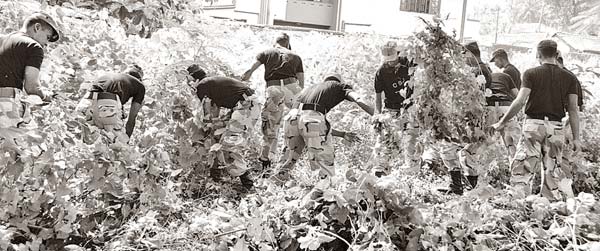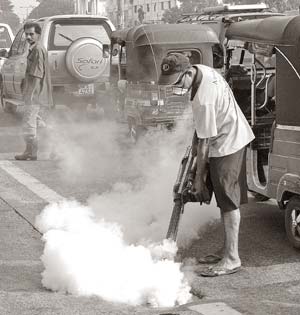Dengue can be controlled
Dr H I Karunadasa
The aim of this article is to draw the Health Ministry’s attention
to consider even at this late stage to go for a National Community Based
long term Action Plan to wipe out dengue from this country.
Participatory Representative Action Planning methods are used in many
developing countries in South Asia and Western Pacific Region Countries
Dengue cases and deaths are on the increase in spite of some
intensive clean up campaigns. In 2007, we repeated the same preventive
measures that are functioning today and did not observe much appreciable
control.
|

Cleaning dengue breeding grounds. File photo |
Cases continued at the same intensity in 2008 and 2009 although we
applied same measures much more vigorously and failed again to see some
effective results although cases ceased in all occasions along with the
monsoon rains coming to an end.
There is an impact of these massive clean-up campaigns in preventing
dengue spreading in major epidemic proportions. Although this impact is
quite obvious during the spreading months of dengue in previous years,
it reveals that something more is needed indicating that short term
measures are blessed with short term impacts.
By resorting to the same process of short term prevention we are
unable to control dengue to the manageable level.
If we evaluate the same preventive measures as reported in printed
and electronic media, there is something deficient in our approaches.
The preventive measures particularly, clean up campaigns were prominent
during the months of May, June and July and to some extent the first
half of August.
Cases started declining in August and along with it people’s interest
also declined as if dengue will not raise its head again. It is a pity
to note that the incidence of dengue continued unabated in 2007, 2008,
2009 and up to the end of July, 2010.
Absence of long term plan
We have no knowledge of any scientific evaluation done to determine
as to what has gone wrong, and what remedial measures should be adopted
to curb this national threat.
The answer is simple.
We did not have a family and community based long term Action Plan.
It is heartening to note that our political sector with other
interested groups and national media are making mighty efforts by
organizing and implementing clean up campaigns.
This is a vital necessity to arrest the present increasing trend of
the incidence of dengue. But, after these clean up campaigns how could
we manage to maintain this clean level. Is it for how long? Will it be
possible to launch such campaigns right through the year?
It is very pathetic to note that this national responsibility is
cleanly forgotten and the nation is suffering heavy losses. If we fail
to organize a community and family based self sustaining long term
action plan and, launch it with the active participation of the
Presidential Task Force working at Grama Niladhari Divisional level, we
are heading for a bigger threat with serious consequences.
Creating awareness is a healthy sign but, one should remember that
there is a gap between knowledge and behaviour. What we should strive is
to direct educational interventions to bring about a behavioural change
so that people develop right attitude and change their own behaviour for
some positive benefits.
In spite of all educational efforts there are some incorrigible in
any community. They are few in number. We have legal measures against
them.
Dengue menace can be controlled by developing a strategy on the basis
of Participatory Representative Techniques (PRT) and go into self
sustaining family and community based long term action planning.
Most members in the public health and health education sector are not
proficient in participatory planning.
Following is that long term action plan that I proposed for the
eradication of dengue in the Kelaniya MoH area.
Strategy
|

Dengue prevention in the city. File photo |
The action oriented small group based process of Participatory
Representative Technique (PRT) at community level is envisaged for the
active involvement of the community. Small groups of families consisting
of 10 to 15 will be identified on the basis of a set of criteria and
action oriented units are formed.
Presidential Task Force Committee working at Grama Niladhari level is
given leadership and the committee member responsible for the families
is expected to work with the public health staff. Each unit will select
their own two representative activists using simple socio-metric
technique.
Objectives
Objectives not included in this. Variables include strengthening of
group behaviour, elimination of mosquito breeding places, quick and
efficient case referrals and measures for sustenance and coordination
with all interested agencies.
Setting the target population
On the basis of the following criteria the entire MOH area is divided
into three units. They are the morbidity incidence of dengue in previous
years and the case distribution, entomological evidence as regards
mosquito density (Particularly aedes agyptae and albopictus), present
outbreak and its distribution and environmental vulnerability.
The three units are high risk area, medium risk area and the minimum
risk area.
A map indicating these three areas are prepared by the staff and
families are identified. High priority was given to high risk area and
about 1,500 families were selected from four PHI areas. All other
activities planned for the area are being carried out in addition to
this program.
Coordination and support
All the field officers of Kelaniya area attached to different
departments that have a linkage to the environment are scheduled for an
orientation of this participatory methodology. Some are already
orientated.
Task Force Committee working at Grama Niladhari level is given direct
responsibility to work with the family level activists. Some of the
members have already been orientated.
This methodology provides them opportunities to coordinate and work
with their own community. Some Kelaniya PS members have already been
briefed for their support.
While educating the entire school population on the preventive
measures of dengue, students above Grade Eight from the high risk area
will be given a separate task of planning to assist family unit level
representatives. They will be orientated as to how to perform this task.
Methodology
Methodologies are available under Participatory Representative
Techniques (PRT). Taking the urgency into consideration the PRT process
is designed to support the Ministry’s ongoing clean up campaigns and
other interventions and to create a family based self sustaining
community infrastructure to implement a long term community based action
program.
This will facilitate to undertake follow up work to sustain the
cleaner and mosquito breeding free environment now we are achieving
through massive clean-up campaigns. The PRT process involves the
following steps.
- Taking into consideration the status of socio-economic,
geographic and housing density the families in high risk area and
breaking them into 10 to 15 workable units.
- The application of simple sociometric tests to select two
representative activists from each unit. They are not selected by
the Public Health staff, but the community.
The members of the Kelaniya health staff have been fully trained by
me as how to conduct this test and full freedom is given to the
community to come out with their nominees. If there are 15 units in a
selected area, there will be about 30 Family Representative Activists (FRA).
- Orientation training of FRAs through group sessions. This
is conducted by the Members of the health staff to apprise them
about dengue and the role of the community in this program. This
will also facilitate planning with the community.
- As mentioned, all the schools in the Kelaniya and the
neighbourhood will be taken up for dengue health education and other
preventive activities. Secondly, schoolchildren from the High Risk
Area will be involved for a separate action plan to coordinate with
community and family level representatives. They will be given
guidelines as to how to develop this plan and implement in the high
risk area.
Community action planning
To pave the way for long term community action planning, the members
of the public health staff working in a particular area need to organize
meetings with FRAs. It is necessary to organize these meetings in
consultations with them at suitable time convenient to them.
Community action planning is the most vital stage of this program and
the sacrifice they make at the beginning will pay good dividends not
only for dengue eradication work but also for other preventive health
work in the area in future.
Implementation
All the FRAs in all the units with family members and high
schoolchildren of the area are responsible for the implementation of the
community action plan as planned according to time frame.
Assistance of the health staff and the coordinating members
particularly members of the Task Force working at Grama Niladhari level
is planned to be made available and is expected to perform their role as
planned.
Monitoring and evaluation
Monitoring should be planned by the health staff so as to
comprehensively cover the effective implementation of the total process.
Remedial measures should be brought in without delay.
Indicators for the purpose of evaluation should be identified during
the planning stage and used at any point of the process to check the
progress and bring in corrective measures. |



